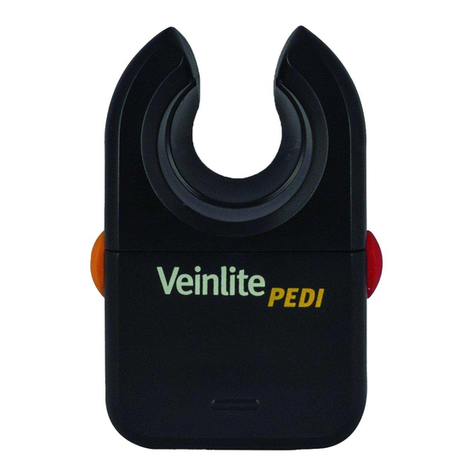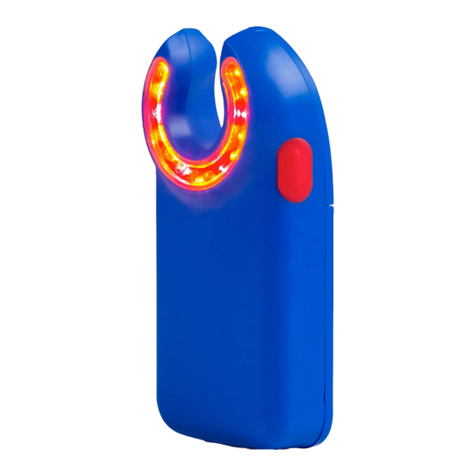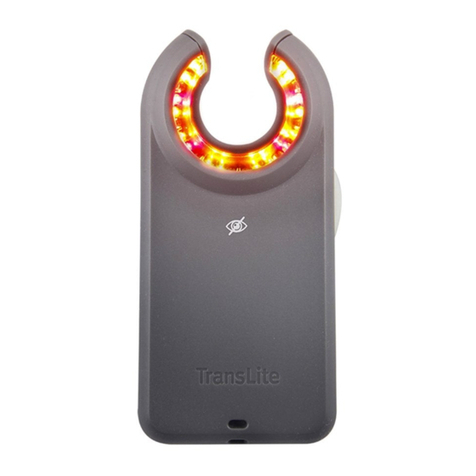
INSTRUCTIONS
Introduction
The Veinlite™ LED is a hand-held battery powered transillumination device for visualizing
veins and superficial blood vessels. It utilizes the patented* transillumination technique
known as side-transillumination, which enables the Veinlite LED to uniformly illuminate a
small region of skin and subcutaneous tissue without any areas of shadow. The shadow-free
side-transillumination technique allows better visualization of veins than any other
transillumination method. The orange LEDs emit light with the optimal wavelength for
highlighting the contrast between the venous blood vessels and surrounding tissue+.
Applications
Venous access in adult and pediatric patients, especially those with a history of
difficult venous access
Easier visualization of veins in darkly pigmented patients
Easier visualization of veins in geriatric patients
Transillumination light for neonatal applications
Description of the Veinlite LED
The Veinlite LED has 24 light emitting diodes (LEDs), mounted in a circular array and angled
towards the center of the circle. 12 LEDs emit orange light and 12 LEDs emit red light. The
light from the LEDs shines through a clear plastic window [1] so that it is focused under the
skin. There is an opening in the circle to allow access.
The light from each set of LEDs has specific characteristics selected for optimal vein
visualization at varying depths and through skins of different tones. The properties of the
orange light are optimal for viewing small superficial veins and for use on patients with very
fair skin, whereas the properties of the red light are optimal for viewing deeper veins and
provide better penetration through darker skin.
Each set of LEDs can be independently selected by pressing one of two separate buttons [2]
located one on each side of the Veinlite LED. The orange LEDs are controlled by the orange
button and the red LEDs by the red button. Both sets of LEDs can be switched on at once by
pressing both buttons at the same time.
Operating Directions
1. Place the Veinlite LED inside the single-use disposable plastic cover. Wipe the area of
the cover coming in contact with the patient with an alcohol swab or germicidal wipe.
2. Turn off any fluorescent lights that are directly overhead, as these may interfere with
the transillumination. Working under non-fluorescent side lighting is optimal.
3. Place the Veinlite LED against the skin with the LED side in contact with the skin.
4. Depress the orange and/or the red button/s [2] to turn on the LEDs.
5. Apply gentle pressure to the Veinlite LED to ensure it is in contact with the skin.
6. Use the orange button only if you are examining small superficial veins on fair skin. Use
the red button also if you are examining deeper veins or if the skin is darkly pigmented.
7. To access a vein while viewing with the Veinlite LED, place the Veinlite LED over the
vein. Rotate the opening in the Veinlite LED so that it faces away from the heart (see
diagrams on next page).
8. Apply gentle pressure on the Veinlite LED to sequester the vein. Push back slightly on
the Veinlite LED to stretch the skin and provide traction. Insert the needle into the vein
in the normal way, through the opening in the circle of LEDs.
9. Discard the single-use disposable plastic cover after each patient.
10. The Veinlite LED may be cleaned periodically with a germicidal wipe but wiping the unit
should be done in addition to using a new disposable plastic cover for each patient.

























